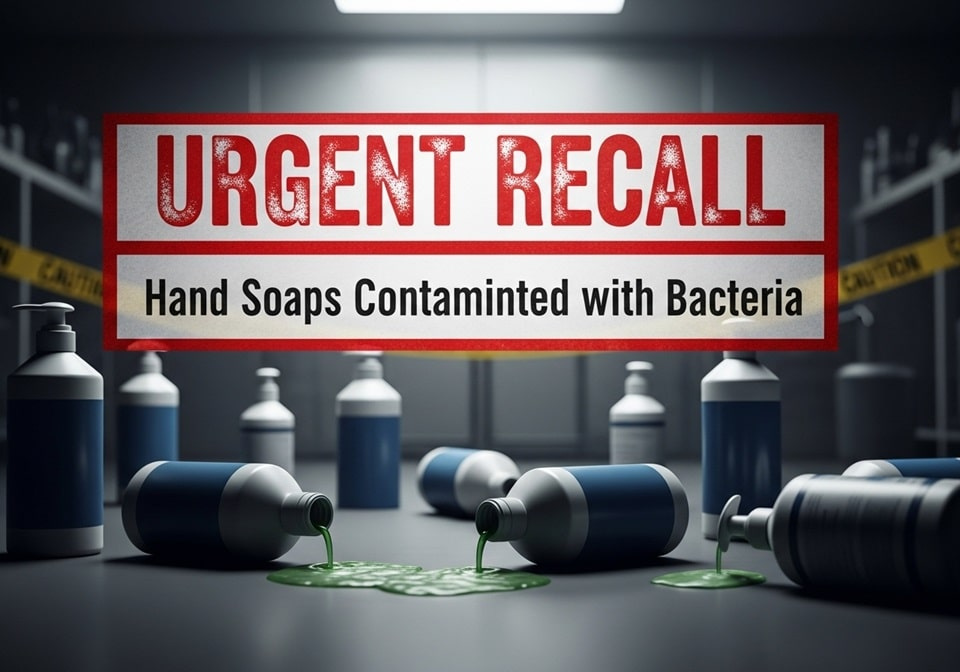
Urgent Hand soap recall: Contaminated with Bacteria Posing Sepsis Risk
An urgent public health alert has been issued following the voluntary recall of several hand soap and lotion products. The recall, initiated by the manufacturer DermaRite Industries, LLC in collaboration with the U.S. Food and Drug Administration (FDA), stems from the discovery of microbial contamination in the products. The bacteria identified, known as Burkholderia cepacia complex (Bcc), poses a significant health risk, particularly to vulnerable populations. This contamination has prompted a nationwide warning, as the bacteria could potentially lead to serious and life-threatening infections, including sepsis. The news has put both healthcare facilities and consumers on high alert, serving as a critical reminder of the importance of vigilance in product safety, even for everyday items like hand soap. This event underscores the rigorous processes involved in ensuring product safety and the swift action required to mitigate public health risks when issues arise. You can find more details about how these recalls are managed by regulatory bodies in The Independent’s news coverage.
The recall affects a wide range of products, including antiseptic lotion soaps, antimicrobial foam soaps, and other cleansers sold under the DermaRite brand. These items were distributed throughout the United States and Puerto Rico. The manufacturer has issued a detailed list of the specific products and their lot numbers, urging distributors, customers, and consumers to immediately examine available inventory. The recall is particularly concerning because these products are often used in healthcare settings, such as hospitals and nursing homes, where they may be handled by or used on immunocompromised individuals. For these populations, an infection from B. cepacia is far more dangerous than for a healthy person. The company’s press release has stated that while no adverse events have been reported to date, the potential risk is severe enough to warrant the immediate and voluntary recall of the products. The prompt action taken by DermaRite and the FDA highlights a robust system for protecting public health, which is a topic frequently discussed in business and health news. For more information, see reports from sources like Fox Business on the impact of recalls.
The bacterium at the heart of this recall, Burkholderia cepacia complex, is a group of bacteria commonly found in soil and water. While it poses little medical risk to healthy people, especially those with intact skin, it can be a serious threat to those with compromised immune systems or chronic lung diseases like cystic fibrosis. According to the Centers for Disease Control and Prevention (CDC), the bacteria can be resistant to many common antibiotics, making infections difficult to treat. If the bacteria enters the bloodstream of an at-risk individual through a cut or lesion on the skin, it can lead to a severe and life-threatening condition known as sepsis. Sepsis is the body’s extreme response to an infection, which can lead to tissue damage, organ failure, and death. The specific risk factors and symptoms associated with B. cepacia and sepsis are critical for both healthcare professionals and caregivers to understand. An understanding of these risks helps in the proper handling and disposal of the recalled products, as well as in the monitoring of potential symptoms in at-risk individuals. The CDC has provided comprehensive information on the bacteria, which is often cited in health-related news. The health risks are frequently highlighted in publications like the CDC’s own information pages.
Details of the Recalled Products and What Consumers Should Do
The voluntary recall issued by DermaRite Industries covers a number of over-the-counter healthcare products, not just traditional hand soaps. The list includes: DermaKleen Antiseptic Lotion Soap, DermaSarra External Analgesic, KleenFoam Antimicrobial Foam Soap, and PeriGiene Antiseptic Cleanser. Each of these products has specific lot numbers and expiration dates that are affected by the recall. It is crucial for consumers and healthcare facilities to check their inventories immediately to identify any of these products. If a product is identified as being part of the recall, the company advises that it should be destroyed in accordance with a facility’s established process. This swift and definitive action is recommended to prevent any possibility of the products being used by someone at risk. For individual consumers, the recommendation is equally clear: stop using the product immediately and either dispose of it or return it to the place of purchase for a refund. It’s important to note that the use of these products on healthy individuals is unlikely to cause a severe infection, but the risk to those with pre-existing health conditions is too high to ignore. The FDA’s involvement ensures that the recall process is followed correctly and that the public is fully informed of the potential risks. Information on what to do with the products can be found on news outlets reporting on the recall, such as the FDA’s official recall notice.
The recall highlights a recurring issue in product manufacturing: the importance of strict quality control. Microbial contamination can occur at various stages of the manufacturing process, from sourcing ingredients to packaging the final product. Companies are responsible for implementing robust testing protocols to catch these issues before products reach the market. The fact that this contamination was discovered internally by the manufacturer and reported to the FDA is a positive sign of a working system. However, it also serves as a stark reminder of the vulnerabilities within complex supply chains. The bacteria’s resistance to antibiotics is also a major factor, as it means that even if an infection occurs, it could be difficult to treat, which is why prevention through product recall is the most effective course of action. The situation illustrates the critical role that both corporate responsibility and regulatory oversight play in maintaining public safety. You can find more information on the complexities of supply chain management and product recalls in business-focused news from sources like USA Today Money.
Understanding the Health Risks: B. cepacia and Sepsis
For most people, a recall of hand soap might seem like a minor inconvenience. However, the mention of “life-threatening sepsis” elevates this from a simple quality issue to a serious public health concern. To understand the gravity of the situation, it’s important to differentiate between the bacterial infection and the body’s reaction to it. Burkholderia cepacia complex is the bacteria itself, which, as mentioned, is generally harmless to healthy individuals. Sepsis, however, is a systemic and often deadly immune response. It happens when the chemicals your body releases into the bloodstream to fight an infection cause inflammation throughout the body, which can lead to blood clots and leaky blood vessels. This, in turn, can result in decreased blood flow to vital organs, ultimately leading to organ failure and death. The risk of this cascading effect is particularly high in people with weakened immune systems, such as the elderly, infants, and patients with chronic illnesses like cancer or cystic fibrosis. The recall is a preemptive measure to prevent a chain of events that could have devastating consequences for these at-risk groups. The distinction between the bacteria and the resulting condition is a key point of public health alerts like this, as it helps people understand why an otherwise common bacteria can be so dangerous. This is a topic that is often discussed in medical and health news reports from outlets like BBC Health.
The widespread use of these products in clinical settings is what makes this recall so critical. Many of the affected products are sold as over-the-counter items but are also commonly used in hospitals, nursing homes, and other facilities where vulnerable people are present. A healthcare worker or a caregiver using a contaminated soap to wash their hands could inadvertently spread the bacteria to a patient with a compromised immune system. This could happen even with a minor cut on the skin of the patient, as the bacteria can enter the bloodstream directly. The recall is therefore a crucial step in breaking a potential chain of transmission that could lead to multiple infections. DermaRite Industries has taken the necessary steps to notify distributors and facilities by email, instructing them to destroy the affected products immediately. This proactive communication is an essential part of the recall process, as it ensures that the products are removed from circulation as quickly as possible. The case serves as a powerful reminder of how important sterile environments and uncontaminated products are in a medical context, and how a seemingly small issue can have wide-ranging repercussions. The issue is a major topic for both consumer health and medical supply news. The Independent has covered this topic in its health section.
Broader Implications for the Skincare and Sanitizer Industries
This hand soap recall is not an isolated incident and reflects broader challenges within the skincare and sanitation industries. In recent years, recalls of hand sanitizers and other personal care products due to bacterial or chemical contamination have become more common. Many of these incidents, including the recall of hand sanitizers contaminated with methanol (wood alcohol), have highlighted the importance of strict regulatory oversight and manufacturer accountability. The rise in demand for these products, particularly during periods of heightened health awareness, can sometimes strain supply chains and lead to a lapse in quality control. This situation with DermaRite’s products is a fresh example of how companies must be vigilant, not only in their own manufacturing processes but also in vetting their suppliers and the raw materials they use. The presence of **B. cepacia** in these products suggests a contamination in a watery environment during production, possibly from a faulty water source or an unsterile piece of equipment. The industry’s response to such events often involves a re-evaluation of their quality assurance procedures and an increased investment in new technologies that can detect contaminants more effectively and earlier in the production cycle. You can find more information about these challenges and industry trends in articles from business and technology news sources like USA Today Money.
Furthermore, this recall underscores the ongoing public health challenge of antibiotic-resistant bacteria. B. cepacia‘s resistance to many antibiotics makes it a particularly problematic organism. This is a topic of increasing concern for public health officials worldwide. The emergence of “superbugs” highlights the need for constant innovation in infection control and the development of new treatments. The recall, in this sense, is not just about a specific brand of soap; it is a microcosm of a larger battle against infectious diseases that are becoming harder to treat. The incident serves as a public reminder of the importance of good hand hygiene, not just to prevent the spread of common germs, but to protect oneself from potentially dangerous, drug-resistant bacteria that can lurk in unexpected places. The public must be aware of such risks and be proactive in checking for recalls on products they use regularly. This vigilance is the first line of defense against potential health risks. This is a topic often covered in global health reports from outlets like BBC Business when discussing the healthcare and pharmaceutical sectors.
Preventing Future Contamination and Ensuring Public Trust
For a company like DermaRite, which specializes in healthcare and infection control products, a recall of this nature is a significant blow to its reputation. Rebuilding public and institutional trust will be a long and challenging process. It requires not only transparent communication about the recall itself but also a clear and demonstrable commitment to preventing future incidents. The company must conduct a thorough investigation into the source of the contamination, implement corrective actions, and communicate these changes to its customers. The FDA’s role in this process is crucial, as its oversight and public alerts provide an essential layer of assurance for consumers. This incident will likely lead to a re-evaluation of product testing protocols across the industry, with a focus on more rigorous microbial testing of both raw materials and finished products. Many companies may choose to invest in new technologies, such as advanced microbial detection systems, to prevent similar issues from occurring. The long-term impact on the industry will depend on how quickly and effectively manufacturers and regulators can learn from this event and implement changes that restore confidence in their products. The process of regaining consumer trust is a common theme in business news. CNN Business often covers corporate responses to such crises.
For consumers and healthcare professionals, the lesson is one of increased awareness and caution. It is no longer enough to simply trust that a product on the shelf is safe. Regular checks of regulatory websites, such as the FDA’s recall page, are an important habit to develop. In a hospital or nursing home setting, quality control must extend beyond the products themselves to include a regular review of supplier information and recall alerts. The responsibility of ensuring safety is a shared one, involving manufacturers, regulators, and end-users. The recall is a powerful reminder that vigilance is the most effective tool in preventing health crises related to contaminated products. It also highlights the need for the public to be educated on the symptoms of serious conditions like sepsis, as early detection is often the key to successful treatment. The ability of the public to act quickly and responsibly in response to such alerts is a cornerstone of an effective public health system. News outlets often play a vital role in disseminating this information. The Independent’s coverage of American news often includes these types of consumer alerts.
The Public Health System in Action
The hand soap recall is a prime example of the public health system working as it should. The system relies on a combination of voluntary company action, regulatory oversight from agencies like the FDA, and timely public communication. When a company discovers a problem, as DermaRite did, it is their responsibility to notify the relevant regulatory body. The FDA then works with the company to assess the risk, confirm the details of the recall, and issue a public alert. This multi-layered approach ensures that information is vetted for accuracy and that the public receives a clear, actionable message. The system is designed to be proactive, aiming to prevent illness and injury before it can occur. While the details of this specific recall are concerning, the fact that the system detected the issue and is working to remove the products from circulation is a positive sign. It demonstrates that the checks and balances in place, though not infallible, are effective in protecting the public from potentially dangerous products. The success of this system depends on the collaboration between the private sector and government agencies. This cooperation is a topic frequently examined by experts in public health and business. The effectiveness of these systems is a point of discussion in various public health publications and news sites.
Conclusion: A Call for Caution and Informed Action
The nationwide recall of hand soaps and other cleansers due to contamination with Burkholderia cepacia complex is a serious event that serves as a powerful reminder of the hidden dangers that can exist in everyday products. While the risk is minimal for most healthy individuals, the potential for life-threatening sepsis in immunocompromised people is a grave concern that necessitates immediate and informed action. The swift response from DermaRite Industries and the FDA highlights the effectiveness of a functioning public health system designed to protect citizens. For consumers and healthcare providers, the key takeaway is the importance of vigilance. By staying informed about product recalls and being aware of the risks, individuals can take proactive steps to protect themselves and those they care for. This event underscores the shared responsibility of manufacturers, regulators, and the public in ensuring a safe and healthy environment for everyone. The story is not just about a recalled soap; it is about the importance of resilience, a functional regulatory framework, and a collective commitment to public safety.









